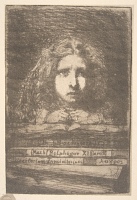Etchings Institutions search term: grolier club
Annie Haden with Books | ||
| Number: | 6 | |
| Date: | 1857/1858 | |
| Medium: | etching | |
| Size: | 97 x 65 mm | |
| Signed: | 'J. W.' in reverse at right | |
| Inscribed: | no | |
| Set/Publication: | no | |
| No. of States: | 1 | |
| Known impressions: | 1 | |
| Catalogues: | K.8; M.10; T.-; W.2 | |
| Impressions taken from this plate (1) | ||
KEYWORD
TITLE
'Annie Haden' (1870s, Whistler). 3
'Annie Haden' (1886, Frederick Wedmore (1844-1921)). 4
'Annie Haden with Books' (1909, Howard Mansfield (1849-1938)). 5
Although Whistler identified this as 'Annie Haden', Mansfield gave it the fuller, descriptive title, Annie Haden with Books to distinguish it from other portraits of the same sitter, such as Annie [7], Annie, Seated [32], and Annie Haden [67].
DESCRIPTION
6: Mansfield 1909 (cat. no. 10) described the titles slightly incorrectly, as 'Swedenborg', 'Machiavelli', 'Belphegor XII', 'Directorium Inquisitorium'.
SITTER
DISCUSSION
7: Lochnan 1984 , pp. 25-26.
8: For instance, Lady with a lantern [m0086], r.: Demon; v.: Two sketches of Nellie Farren [m0666].
9: 'Nulla dies sine linea': (a) Monk writing; (b) An old man in a nightcap reading; (c) Whistler changing clothes with a 'Pleb' [m0193].


